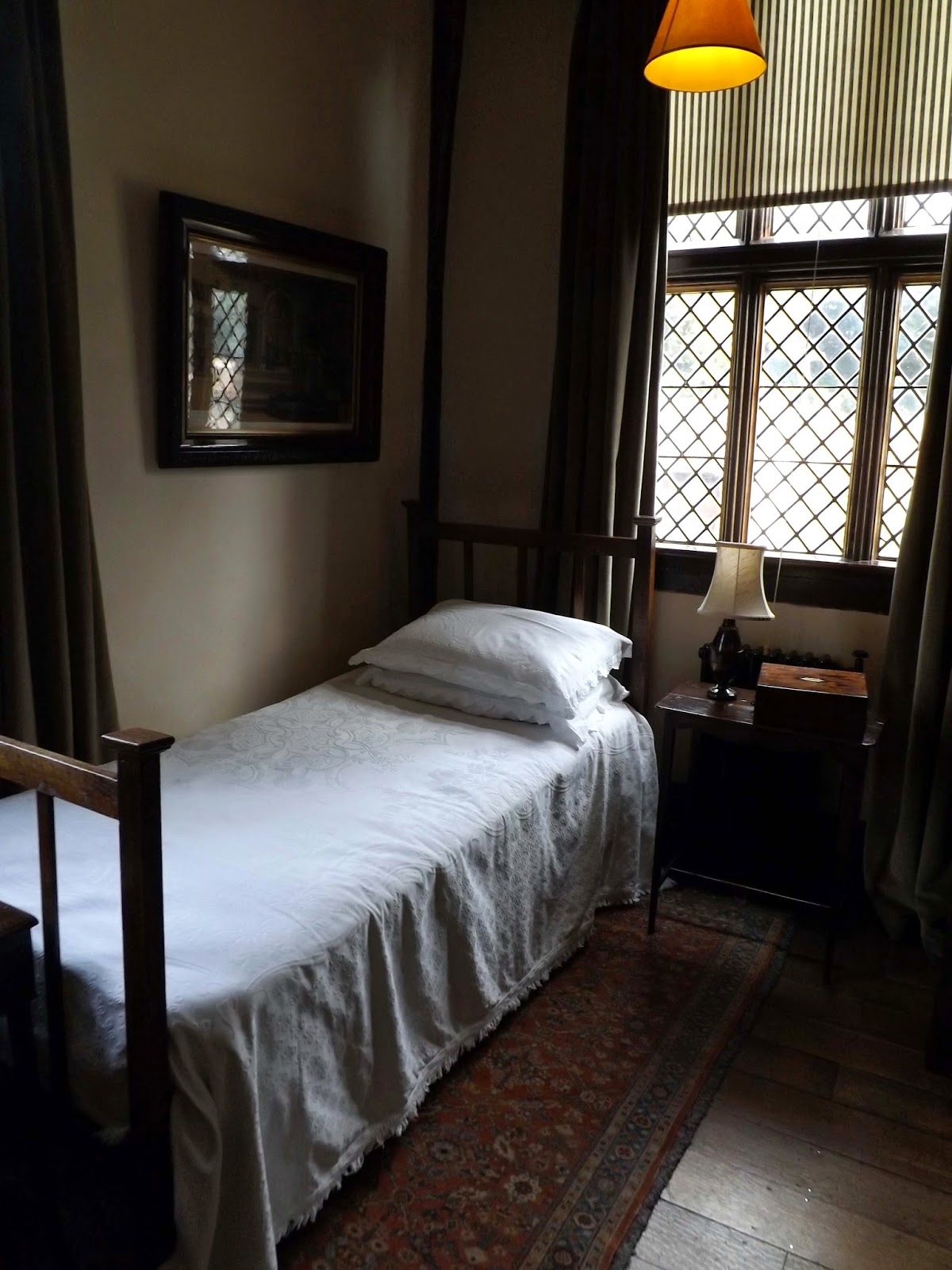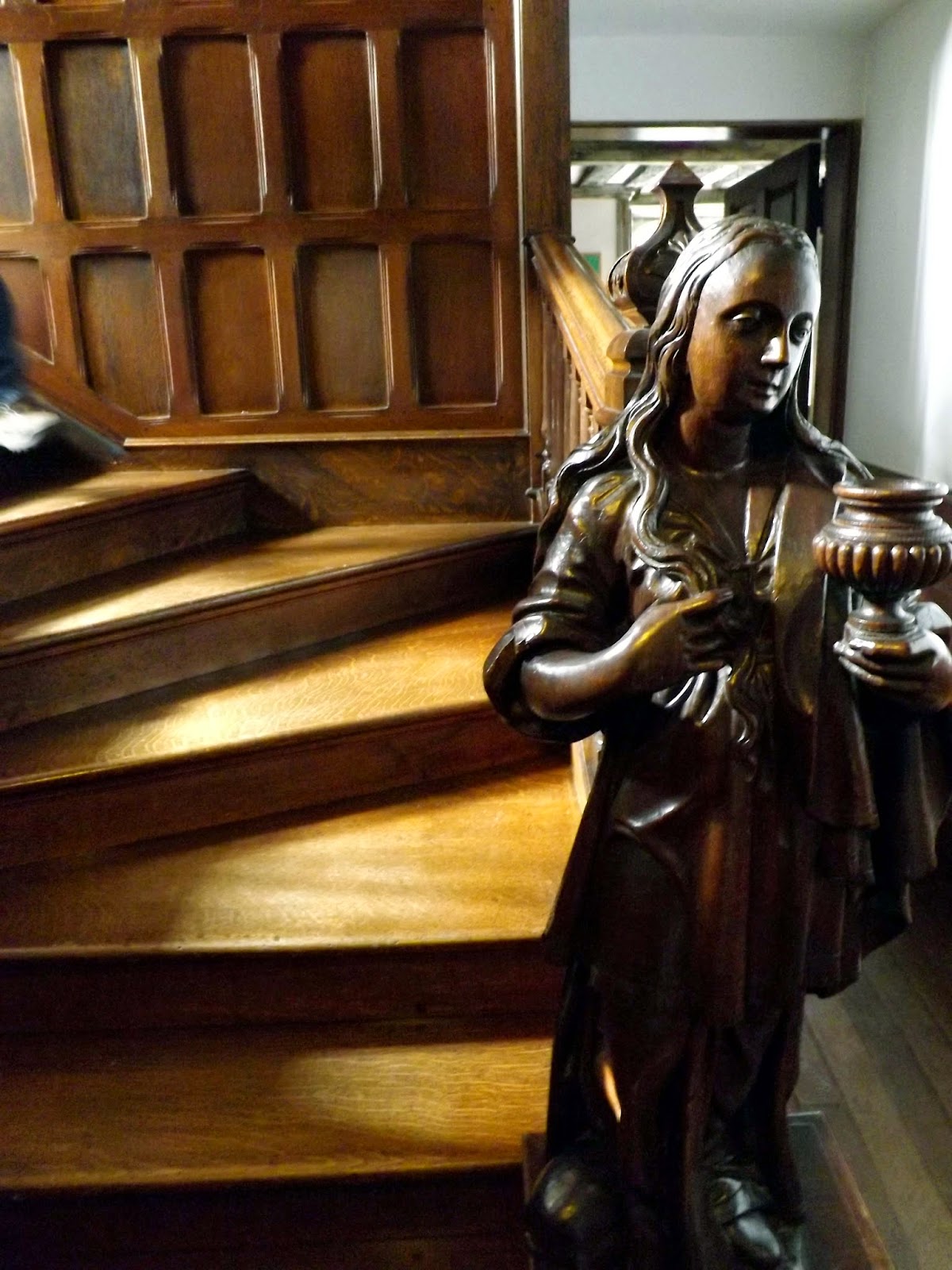Ightham's Saxon name was Ehteham. At the foot of a hill, with a moat fed by the Shode, stands the small fortified manor house of Ightham Mote which has a fascinating, though blood-thirsty history.
Originally dating to around 1320, the building's importance lies in the fact that successive owners effected relatively few changes to the main structure, after the completion of the quadrangle with a new chapel in the 16th century. Nikolaus Pevsner called it "the most complete small medieval manor house in the country", and it remains an example that shows how such houses would have looked in the Middle Ages . Unlike most courtyard houses of its type, which have had a range demolished, so that the house looks outward, Nicholas Cooper observes that Ightham wholly surrounds its courtyard and looks inward, into it, offering little information externally.
There are over seventy rooms in the house, all arranged around a central courtyard. The house is surrounded on all sides by a square moat, crossed by three bridges. The earliest surviving evidence is for a house of the early 14th century, with the Great Hall, to which were attached, at the high, or dais end, the Chapel, Crypt and two Solars. The courtyard was completely enclosed by increments on its restricted moated site and the battlemented tower constructed in the 15th century. Very little of the 14th century survives on the exterior behind rebuilding and refacing of the 15th and 16th centuries.
The structures include unusual and distinctive elements, such as the porter's squint, a narrow slit in the wall designed to enable a gatekeeper to examine a visitor's credentials before opening the gate. An open loccia with a fifteenth-century gallery above, connects the main accommodations with the gatehouse range.
 |
| Note the narrow slit in the wall designed to enable a gatekeeper to examine a visitor's credentials before opening the gate |
 |
| Mistletoe was growing everywhere |
Its now 11.04am and the house is open, we enter and we first go through the conservatory where we are greeted and handed maps of the house. Andy joked the maps resembled Cludeo and came to the conclusion it was with the candlestick in the Billard room.
The Selbys
The house remained in the Selby family for nearly 300 years. Sir William Selby bought the house from Charles Allen in 1591. He was succeeded by his nephew, also Sir William, who is notable for handing over the keys of Berwick-upon-Tweed to James I on his way south to succeed to the throne. He married Dorothy Bonham of West Malling but had no children. The Selbys continued until the mid-19th Century when the line faltered with Elizabeth Selby, the widow of a Thomas who disinherited his only son. The house passed to a cousin, Prideaux John Selby, a distinguished naturalist, sportsman and scientist. On his death in 1867, he left Ightham to a daughter Mrs Lewis Marianne Bigge. Her second husband, Robert Luard, changed his name to Luard-Selby. She died in 1889 and the executors of her son Charles Selby-Bigge, aShropshire land agent, put the house up for sale in July 1889.The Colyer-Fergussons
The Mote was purchased by Thomas Colyer-Fergusson. He brought up his six children at the Mote. In 1890-1891, he carried out much repair and restoration, which allowed the survival of the house after centuries of neglect. He converted a lumber room into a billiard room, added bathrooms and central heating, reorganised the kitchen and dining areas and carried out countless repairs. Ightham Mote was opened to the public one afternoon a week in the early 20th century.Sir Thomas Colyer-Fergusson's third son, Riversdale, died aged 21 in 1917 in the Third Battle of Ypres, and won a posthumous Victoria Cross. A wooden cross in the New Chapel is in his memory. The oldest brother, Max, was killed at the age of 49 in a bombing raid on an army driving school near Tidworth in 1940. One of the three daughters, Mary (called Polly) married Walter Monckton.
During the Second World War, the reduced staff slept in the crypt to shelter from air-raids, and a German pilot was held there for a single night after parachuting onto the estate from his stricken plane.
On Sir Thomas's death in 1951, the property and the baronetcy passed to Max's son James, a lifelong bachelor. The upkeep and repair of the house left him in no option but to sell the house and auction most of the contents. The sale took place in October 1951 and lasted three days. It was suggested that the house be demolished to harvest the lead on the roofs, or be divided into flats. Three local men banded together to save the house purely for love of it: William Durling, John Goodwin and John Baldock. They paid £5,500 for the freehold, confident that some other, richer, benefactor would emerge.
We entered the Billiards room first and were greeted and told some of its history.It was turnt into a games room during the Victorian period when the panelling was added. In the Corner on the windowsill was a barometer. The room was full of elaborate furniture like the one pictured below.
Joined onto the Billiards room was the applestore.
Charles Henry Robinson
In 1953, the house was purchased by Charles Henry Robinson, of Portland, Maine, a bachelor. He could stay for only fourteen weeks a year for tax reasons. He made many urgent repairs, and partly refurnished it with 17th-century English pieces. In 1965, he announced that he would give Ightham Mote and its contents to the National Trust. He died in 1985 and his ashes were immured just outside the crypt. The National Trust took possession in that year. |
| A large kennel built in the late 19th century for a St. Bernard named Dido is the only Grade I listed dog house. |
We now entered the Great Hall. The Great Hall was built in 1340 by Sir William Cawne. It was positioned on the moot, an ancient gathering place.
Again we were met by a volunteer and further history was explained. These volunteers were very helpful.
 |
| The door on the left is apparently where the butter was kept. |
We moved on through to the kitchen. Below is pictured the servants board from where they could be called. Nect to that is a huge safe where the silver would have been kept.
We move on through the house and to the Crypt.
The manor house had a crypt which was below the water level of the moat - and this allowed the swift disposal of prisoners occupying the prison by the opening of a sluice gate.
The tower at Ightham Mote was added at the time of the Wars of the Roses. During this time a trap was included in the floor of a room in the tower so that suspicious visitors could be dropped into a small dark hole where they would be left to starve. A ghost of an unlucky visitor is said to haunt the room above the main gate.
 |
| Victorian style toilet |
 |
| One of the Solar Bedrooms |
 | |
| The New Chapel, one of two chapels. The ceiling is painted in the 1500s in homage to King Henry VIII. |
After walking through the Library we exit out into the courtyard and back out of the site.
 |
| A converted Oast house that can be seen from The Car park. |
We stop off in The George and Dragon for a pint. I ordered a pint of Shepherd Neame MasterBrew and Andy has a pint of Whitstable Bay and a packet of crisps each. Both were gorgeous ales and a lovely pub too.
The George and Dragon was originally a manor house, then a coaching inn - but its history is even more impressive. Legend has it that this is where Guy Fawkes hatched his infamous Gunpowder Plot and was captured after fleeing London when it failed. Queen Elizabeth I is also rumoured to have stayed here.
 | |
| Seems to be a funny road name wherever we go !! |
 |
| St Peters Church, Ightham |
The parish church dates from the 12th century, and in 1336 Edward II granted a request for permission to hold an annual fair in the village.
Ightham was famous for growing Kentish cob nuts. These seem to have been cultivated first by James Usherwood, who lived at Cob Tree Cottage. There was a public house nearby called the Cob Tree Inn, which has now reverted to a private house. There are still a number of cob trees in and around the village, but the work of pruning them and picking the nuts is labour intensive, and the industry has fallen into decline.
We left and made our way home after another great day out!










































































